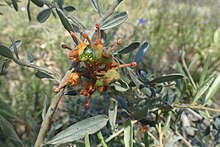Grevillea floribunda
| Seven dwarfs grevillea | |
|---|---|

| |
| Scientific classification | |
| Kingdom: | Plantae |
| Clade: | Tracheophytes |
| Clade: | Angiosperms |
| Clade: | Eudicots |
| Order: | Proteales |
| Family: | Proteaceae |
| Genus: | Grevillea |
| Species: | G. floribunda
|
| Binomial name | |
| Grevillea floribunda | |

Grevillea floribunda, commonly known as seven dwarfs grevillea,[3] is a species of flowering plant in the family Proteaceae and is endemic to eastern Australia. It is a spreading shrub with oblong to egg-shaped leaves with the narrower end towards the base and groups of six to twenty flowers covered with rusty brown hairs.
Description[edit]
Grevillea floribunda is a spreading shrub that typically grows to a height of 0.4–1.8 m (1 ft 4 in – 5 ft 11 in). Its leaves are oblong to egg-shaped, mostly 20–80 mm (0.79–3.15 in) long and 2–20 mm (0.079–0.787 in) wide and softly-hairy on the lower surface. The flowers are arranged in groups of six to twenty, usually at the end of branches, the perianth is greenish and covered with woolly, rusty-brown hairs and the pistil is 9.0–19.5 mm (0.35–0.77 in) long. The ovary is sessile and the style is reddish. Flowering occurs in all months with a peak in spring and the fruit is a hairy follicle 10.5–17 mm (0.41–0.67 in) long.[3][4][5][6]
Taxonomy[edit]
Grevillea floribunda was first formally described in 1830 by Robert Brown in his Supplementum primum Prodromi florae Novae Hollandiae.[7][8] The specific epithet means "profusely flowering".[9]
In 1994, Peter M. Olde and Neil R. Marriott described two subspecies of G. floribunda and the names are accepted by the Australian Plant Census:
- Grevillea floribunda R.Br. subsp. floribunda[10][11]
- Grevillea floribunda subsp. tenella Olde & Marriott[12][13]
Distribution and habitat[edit]
Seven dwarfs grevillea grows in forest and woodland and is widespread on the tablelands and western slopes of New South Wales and in south-eastern Queensland.[3][14] There is a single doubtful record from the Killawarra Forest in Victoria.[4] Subspecies tenella is restricted to the Darling Downs region of Queensland.[13]
Conservation status[edit]
Grevillea floribunda is currently listed as Least Concern on the IUCN Red List of Threatened Species. It is an extremely widespread and common species with a stable overall population and no known major threats. Minor, localised threats include inappropriate fire regimes and land clearing for agriculture.[1]
References[edit]
- ^ a b Forster, P.; Griffith, S. (2020). "Grevillea floribunda". IUCN Red List of Threatened Species. 2020: e.T113017865A113309355. doi:10.2305/IUCN.UK.2020-2.RLTS.T113017865A113309355.en. Retrieved 6 January 2024.
- ^ "Grevillea floribunda". Australian Plant Census. Retrieved 27 October 2021.
- ^ a b c Makinson, Bob. "Grevillea floribunda". Royal Botanic Garden Sydney. Retrieved 27 October 2021.
- ^ a b Makinson, Bob. "Grevillea floribunda subsp. floribunda". Royal Botanic Gardens Victoria. Retrieved 27 October 2021.
- ^ Wood, Betty. "Grevillea floribunda subsp. floribunda". Lucid Keys. Retrieved 27 October 2021.
- ^ "Grevillea floribunda". Australian Biological Resources Study, Department of Agriculture, Water and the Environment: Canberra. Retrieved 27 October 2021.
- ^ "Persoonia floribunda". APNI. Retrieved 27 October 2021.
- ^ Brown, Robert (1830). Supplementum primum prodromi florae Novae Hollandiae:. London. p. 19. Retrieved 27 October 2021.
- ^ Sharr, Francis Aubi; George, Alex (2019). Western Australian Plant Names and Their Meanings (3rd ed.). Kardinya, WA: Four Gables Press. p. 200. ISBN 9780958034180.
- ^ "Grevillea floribunda subsp. floribunda". Australian Plant Census. Retrieved 27 October 2021.
- ^ "Grevillea floribunda subsp. floribunda". Australian Biological Resources Study, Department of Agriculture, Water and the Environment: Canberra. Retrieved 27 October 2021.
- ^ "Grevillea floribunda subsp. tenella". Australian Plant Census. Retrieved 27 October 2021.
- ^ a b "Grevillea floribunda subsp. tenella". Australian Biological Resources Study, Department of Agriculture, Water and the Environment: Canberra. Retrieved 27 October 2021.
- ^ "Grevillea floribunda". Atlas of Living Australia. Retrieved 27 October 2021.

